In January I noticed that something wasn’t quite right with Tonka. In December he’d been offering a lofty, energetic trot, something he hadn’t been capable of before. We both felt strong and buoyant. We’d worked hard to get to this point. We’d been doing cross-training – hills in the woods and suppling exercises in the ring. I’d increased contact, asked for more, and got it, with enthusiasm. But in January something didn’t feel as fun. There wasn’t anything overt to point to, but something was off.
Then Tonka started twitching his head as if flies were bothering him. At first, this head twitching happened maybe twice in a ride, usually when I picked up the reins, which requires him to arch his neck a bit and bring his nose slightly in and down. It was as if Tonka was trying to shake off the contact. It can seem like a disobedience. I confess that I sharply said, hey! to him. I even slapped him on the neck. Stop that! Which I knew wasn’t going to help at all. I’m human, which means I get annoyed and I blame others.
But I know my horse and I knew that this had nothing to do with him being lazy or wanting to “blow me off.” The question was, what was bothering him? When animals don’t do as asked, it’s because they see their avoidance behaviors as the best options. With Tonka, such ear twitching is sometimes a tell – there’s something annoying him, and it didn’t actually have to do with the ears. Why was he annoyed at the work that we were doing? The answer wasn’t obvious.
Tonka would twitch his head like this. Watch for it.
Not a big deal. Under saddle he was sound, and we were still working on our dressage moves, with success. But I know my horse. What was he saying? My trainer, Kim Litwinczak, watched him go and thought that perhaps the bridle was bothering him. Tonka has short, squat (and adorably pointed) Paint horse ears. I got a crown piece that is cutaway to give his ears more room.
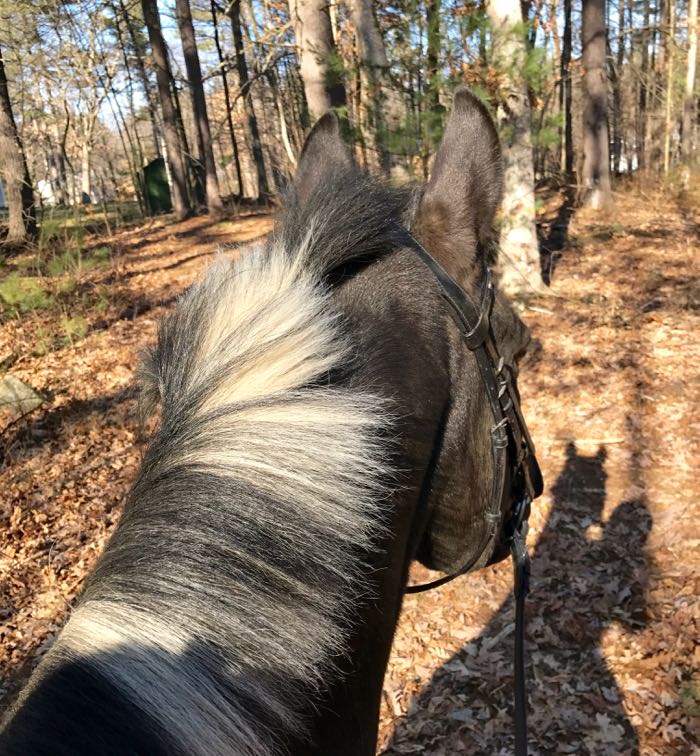
I think that Tonka appreciated that change, but the head shakes continued, and became more frequent.
Then I noticed a swelling near his poll. One day in the barn aisle the light shone on him in such a way as to highlight it. Subtle, but there. Perhaps this time the ear twitching wasn’t an emancipated behavior. Perhaps his ears really did bother him!

Once I looked, I could see asymmetry.
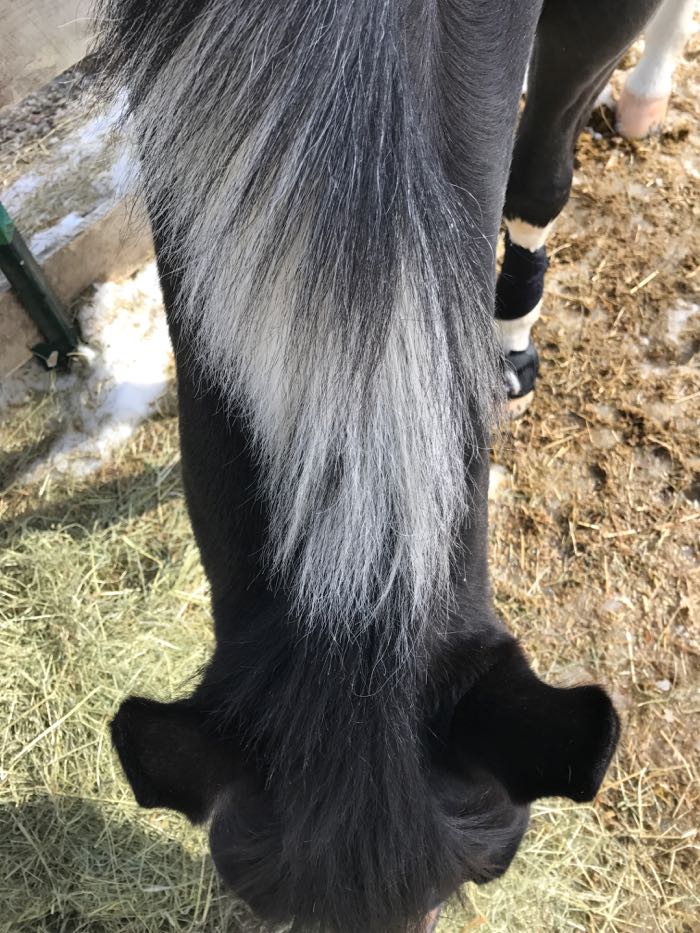
Correct dressage work develops the horse’s top-line. The muscles along the mane form a beautiful arc. By December, with steady and correct exercises we’d achieved this.

But by February, Tonka’s neck was developing distinct muscles along the bottom, looking more like what is called a ewe neck.
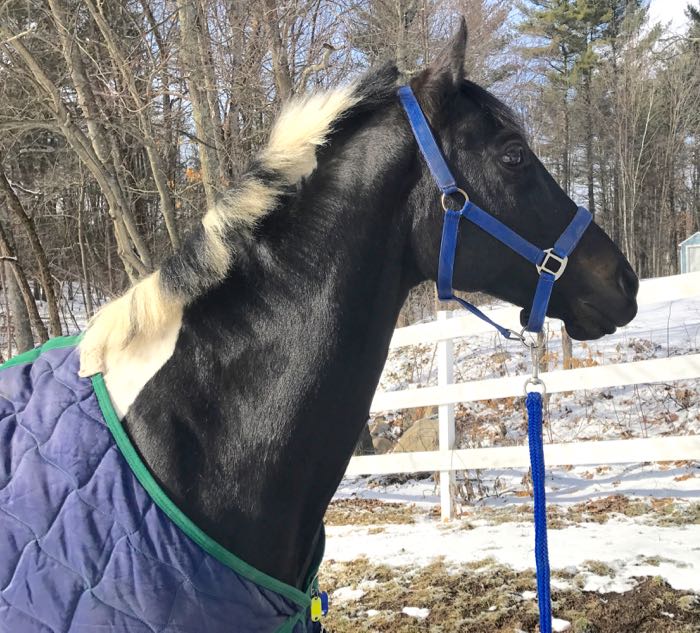
I called the vet. She was surprised that I had her in for such mild symptoms. A horse that twitches his ears three times in an hour ride is not usually a candidate for a farm call. She examined Tonka. His teeth were fine (horses can develop sharp points on their molars which cause pain.) Although Tonka’s back was a tad sore on the left side, that wasn’t the problem. (I contacted my saddle fitter and we adjusted the pad for that issue.) The vet thought that perhaps Tonka had taken a spill on the ice and wrenched his neck. She felt distinct soreness and swelling near the poll. He was prescribed pain killers (rather like our ibuprofen) for ten days, and I was advised to ride him long and low, and to have him do neck stretches to the right and left until the kinks were worked out. I did, but after two weeks there wasn’t much improvement.
That’s when a friend at the barn (thanks, Trina!) pointed out that because of the snow, Tonka was now tall enough to eat out of his hay net like this:
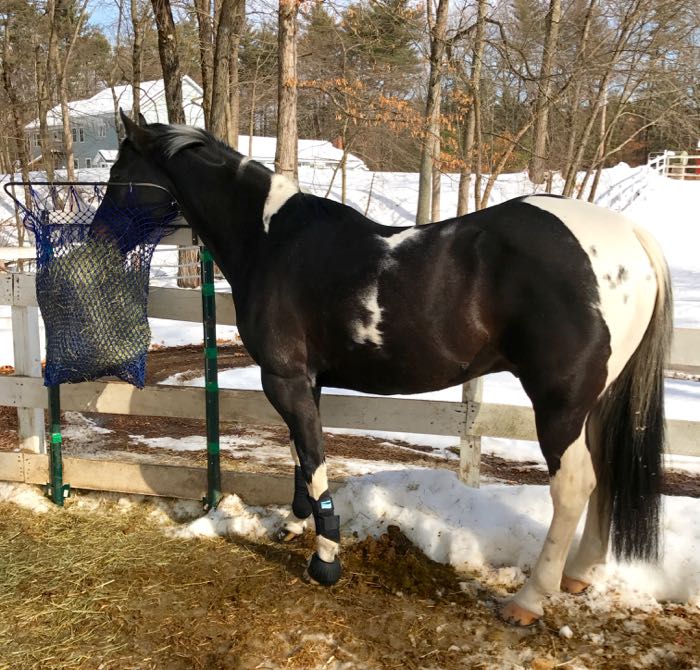
Tonka was delighted to have easy access to the hay, but this isn’t the way that nature intended horses to eat! This could certainly cause pain in his jaw and neck.
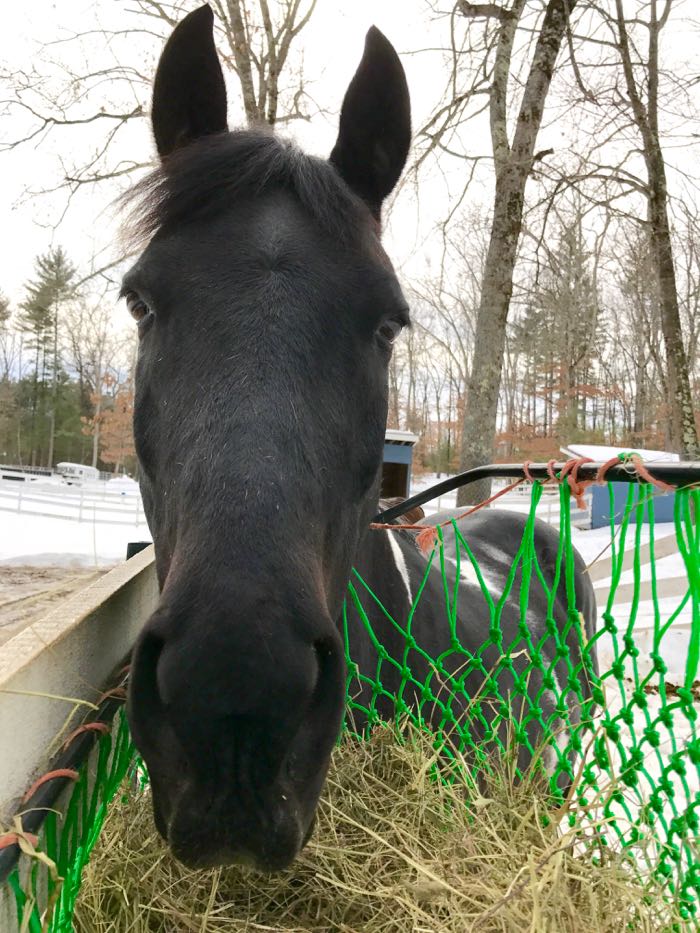
Tonka was put into a paddock with a taller hay net, but that didn’t solve the problem, as my horse has decided that eating like a giraffe is his preferred stance.

Note what this does to his back. Tonka’s back is now tight and sore.
There are many reasons to feed from hay nets. When hay is placed on the ground, the horse ingests dirt, which can cause sand colic; they trample on the hay, which is wasteful; and they eat quickly, which means that they don’t have anything in their bellies for long stretches of time to buffer stomach acids, which can cause ulcers. Slow feed hay nets are a good idea. But this style isn’t right for Tonka. He’s now getting his hay on the ground.
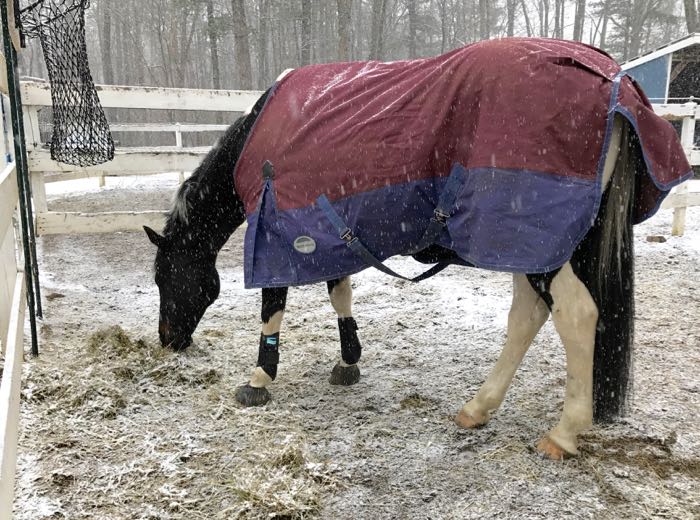
There are various options other than nets to feed hay slowly and without waste. I’ll be discussing them with the farm owner. We should be able to come up with something that works for her, the staff, the facilities, and Tonka.
So, back in January, Tonka did have something to say to me, but it took some sleuthing to figure out what it was. In the meanwhile, it’s back to taking it slow, building up the correct muscles, and stretching out the tight ones.
Do you have a slow hay feeder for your horse? Tell me about it in the comments.


Every year in Sacramento, we look forward to attending the Western States Horse Expo. It is an amazing event for everything horses. Last year, I saw a slow feeder called a Porta-Grazer, that might be a workable solution for Tonka. I have not had the chance to purchase one yet, but it is high on my list! Horse expos are a great place to shop for new and different products all in one place. Maybe there is one on the East Coast you could attend to find options for Tonka.
I know someone who uses a porta-grazer for a horse who can’t graze because of metabolic issues. She and her horse love it. I do go to a horse expo – we have a huge one here called Equine Affaire. In fact, I’ve sent in my application to be a presenter!
I also use small mesh hay nets. I can hang them lower because the holes are too small for them to get a foot caught in and they are sturdy (Nag Bag), so I feel comfortable that they won’t develop a hole quickly. The Hay Pillow is a nice hay bag for the ground, but only for barefoot horses. I recently purchased one of these and am hoping that it holds up since it was a bit pricey. A friend uses Porta Grazers for her 2 horses and really likes them.
A friend uses the hay pillows for her horse and goats. She loves them. She says that it’s worth getting the pillows with the nets that attach with velcro, because those can be replaced for less money than buying a new one. Also, our local horse blanket laundry repairs the nets!
Hi Terry
Your horse is very lucky to have you! I use slow feed hay nets that hang. I have been concerned for some time that they might build the wrong muscle in his neck and topline.
I like the hay pillows and get the slow feed size netting of 1 1/4 inches. They do have a larger size. It is usually muddy so I anchor them to the ground inside their shed or outside on a matt. My mini donkey and 16.3h horse love them. My friend even took a picture of my horse napping using his hay pillow as a pillow lol.
I’m in the process of checking out the porta grazer or the haygain forager. Both are very expensive initially but much more durable. I will say that the hay pillows are sturdier than regular hay nets and worth the extra money.
Please let me know if you find better options out there. Would also love to meet you if you ever end up in the Fishkill ny area. We spoke some time ago about my needle phobic horse. He has come a long way and injects himself intramuscular lyrics but an intravenous blood draw is still an issue.
Annie
Congratulations on your success with your horse! Well done! The blood draw is really just a case of teaching the shot but adding duration. Perhaps if you train it that way? I’d love to come out your way. Anyone else out in that area? If a few of my readers have me out on the same day, then the travel fee is affordable.
My horse has shoes and I worry about them getting caught in the pillows. I’ve used slow feed nets, hung low in stalls, but I’m beginning to think that they cause back issues. I don’t like how my horse has to twist his head to get the hay out. As always, it’s a compromise – a net is better than a horse going for hours without food.
Hi Terry
Keep in touch. Would love a session with you to get everything right for the blood draw. We have come a long way. Reward based training can seem so easy in the beginning until you realize you have reinforced other behaviors that were occurring simultaneously ugh lol. I would like to get him in a calmer state even though he is excited in a positive way as you know this is not the energy wanted when working on phobias. I have not worked enough on rewarding him for standing and doing nothing. He is still thinking he has to be doing something actively or targeting. This is why I need to teach duration too otherwise he is moving or expecting during the blood draw.
I will try to send you video of where we are so you can get an idea of where we need to go.
Annie
HI, I use tyres (tires) and haynets. I fill the net as usual but instead of hanging it up I push it into the middle of a tyre that is lying flat on the ground and fix it in by looping the hanging rope through the tyre and back through the net. It works a treat, I have three or four tyres and I move them around the pen. this cuts out waste and allows a more natural feeding
feeding position.
That’s very clever. I also like changing things around for the horses. Anything to add interest to their day.
Thanks for sharing Tonka’s interesting problem! I hope his new feeding style was the sole cause of the problem and his body returns to comfort and symmetry.
We don’t use hay nets/bags except when we go horse-camping. At home, Lance get his hay on the floor of his stall in a corner without bedding, so he can “graze” in a normal position, even more important because of his COPD. I am also feeding more times a day whenever possible, rather than just twice a day.
I’ve gone horse camping on organized rides, on the wrangler’s horses, and where we went, the horse were turned loose to graze (serious wilderness areas.) At the time I didn’t pay any attention to what the horses ate or how it was packed in. I was too tired at the end of the day! Horse camping sounds like a lot of fun. Have you blogged about it?
Yes, I have; look under my horse blog’s labels for “horse-camping.”
Terry, you clearly have this well in hand. And once again, Tonka is lucky to have someone who cares so much and has such astute and well honed observational skills. What a lucky boy. I have only one thought if you don’t see improvement….internal ear issue? And I agree, his ears are ADORABLE.
Ear mites or an infection was the first thing that I thought of. Although Tonka likes a good scratch in his ears, they’re clean of those issues.
Hi, Terry!
This is one of the challenges of living in a cold climate and densely populated location that requires horses to be fed hay during the winter, and the solution is something that I ponder every time I feed. The slow-feed hay nets certainly provide the benefit of slowing the process of ingestion, but there is a huge trade-off in mobility. The horses stand quite literally in a single spot for as long as the hay lasts. In my opinion, that’s far worse than a stretch without eating. If you watch a horse grazing, you will see that they move constantly: My mare moves every 1-5 seconds; 5 is very rare! She takes a bite, and she takes a step. Even if she’s standing in a particularly lush or delectable patch of grass, she will move away from it then move back to it. But she is always, ALWAYS moving. (Think about the math: If they move even every 3 seconds, that’s 20 x minute, 120 x hour . . . that’s why horses in their natural environment can cover 18-20 miles a day, just in the process of grazing!)
Also, even when horses have perfect foraging–sufficient pasture but not too lush–they will take breaks during the day to nap, stand in the shade, groom each other. That makes it clear that they do not need to be grazing/eating constantly.
My imperfect solution is to spread the hay over a large area (nearly an acre) to simulate grass grazing as much as possible. Yes, some does get wasted, but not very much. The herd of four will circle back repeatedly to go over and over the area where the hay had been spread; by the next feeding, it can be hard to even detect where it had been. When the weather is extreme, they also have hay nets inside their run-in shed (in addition to the spread hay), secured to loops but on the ground (all of the horses are barefoot) so that they can continue to ingest and digest during the coldest weather.
Interestingly, I have fed them in pouring rain, in bitter-cold wind chills, and in almost white-out blizzard conditions; I spread hay outside and hang the nets inside: They have never–not once–chosen to eat from the hay nets first. They all stand outside in the rain/snow/bitter cold and eat the hay from the ground before they go inside to the hay nets.
So something to think about! Which is more detrimental: To go for a period without ingesting food or to stand without moving for hours on end? I firmly believe that the immobility is more harmful. In any case, I do agree with you 100% that horses need to be eating from the ground! They have evolved for millions of years as animals that graze from the ground, and I’m convinced that it’s vitally important to them that they reach down to the ground to eat and drink. It keeps the entire body stretched out, it reduces inhalation of debris, and helps keep the teeth healthy and properly worn down so that those hooks are less likely to develop (the grit they take up with grass/hay).
I’m happy that you figured out why your little Tonka was uncomfortable and hope he’s feeling better soon!
Ellen
Hi Ellen! Thanks for sharing your thoughts on this with us. I agree that horses stand around too much, waiting for, and eating food in one spot. I’m not sure that I agree that immobility is more harmful than an empty stomach. Also, the situation a horse is in often includes both – a small paddock and hay only twice daily. It’d be wonderful if horses didn’t have to deal with either of those options. A student of mine offers hay in the pillows, in several places in her large paddock. That works for her, and her gelding moves and eats all day. I agree that grit is good, but if your turnout is sand, a horse can get colic, especially if hay is limited and the horse tries to eat up every last bit off of the ground. It’s all a balance, isn’t it? One compromise for stalled horses is hay on the floor of the stall, but in slow feeders outside. Those of us in boarding situations have to do the best we can. One reason that I ride daily is to keep my horse moving. When there isn’t snow on the ground, I hand graze at least a half-hour daily. Tonka and I are both ready for this snow to melt!
It’s all a compromise to do as best as we can for the horses. I have plenty of acres for them to move around, a lot of it is woodlands, so it hasn’t grass enough to support them throughout the year so I feed hay most of the year. We also spread it around for them to hunt for it and graze as naturally as possible. But I don’t have a nice indoor arena to ride in so when we have bad weather I don’t get to ride often like you get to ride Tonka. Like now it’s fixin to storm or rain, so I couldn’t ride today.
No one around here uses those slow hay feeders, so I don’t know much about them. Hopefully you will find a solution. I love that picture of Tonka looking face on with his head in the top of his hay feeder. Do you use those hay pillows for horses with shoes?
I wouldn’t use the pillows with horses with shoes – especially not in the winter when my horse has little studs on them to prevent slipping on ice. I, too, love that photo of Tonka with his head in the feeder. He looks so pleased with himself!
We use Slow Grazers on our farm. Feeding in an upright position not only develops the ewe neck but also the teeth aren’t aligned for chewing, and the head needs to be down for nasal drainage.
We tried nets too but they are definitely not safe to use unless up above horse leg level. It only takes one time of having a horse get a leg caught in a hay net to learn that lesson. We were also seeing tooth damage from horses constantly biting at the net.
To get around the ‘horses standing in one place all day’ problem we have multiple Slow Grazers in each pasture. The horses constantly rotate between feeders keeping them moving.
Good luck, this is one of those age-old horse problems!
I’ve seen teeth damage from the slow grazer boxes that have the metal grates. They get wear along their top front teeth. Not all horses will, but it’s serious when it happens. Do you have those metal grates and have you seen that?
Yes we have the metal grates, and we haven’t seen teeth damage from that. Our horses use their lips to pull the hay up, and each time they pull up a bit it leaves a wisp of the next bite to graph. We did have a mare get teeth damage from a net though before we started using the metal feeders because she was biting the net with each bite of hay, couldn’t get any otherwise. I’m sure it depends on the individual horse and how they are using the individual feeder. No one size fits all.
One thing I’d never do is nets below wither level though. Just too dangerous. We lost a beautiful colt that way at a farm I worked on years ago, he had a net that was tied high but must have gotten it down, and got his legs wrapped in it. Just awful. Now I realize why the TB farms back east all tied their nets outside the stalls.
Terrible story about the colt. When you have goats (like I do, two pet wethers) you manage to see danger everywhere – because if they can get tangled in something, they will. I like to give everything the goat test -if it’s not safe for them, it’s not safe for the horses 🙂